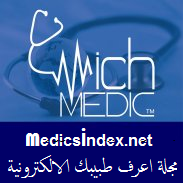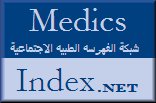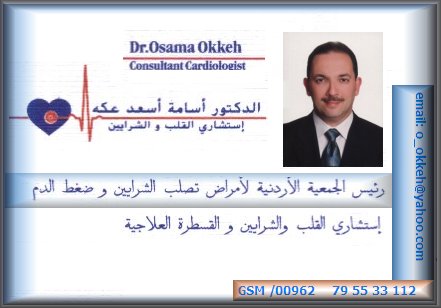|
|
|
|
||
|
||||||||||||||||||
|
|
||||||||||||||||||
|
|
||||||||||||||||||
|
|
||||||||||||||||||
|
MEDICSINDEX
|
|
M D -M S C - P H .D – M R C P Chairman of Jordanian Atherosclerosis & hypertension Prelusion Society. Consultant Cardiologist - LONDON -EGYPT. M R C P - P h .D - M S. Participated in many studies and Research, about hypertension and lipid disorders and arterioscleroses in Jordan and worldwide, participated in many articles and lectures as well workshops. |
|||||||
Atherosclerosis (ath"er-o-skleh-RO'sis) comes from the Greek words athero (meaning gruel or paste) and sclerosis (hardness). It's the name of the process in which deposits of fatty substances, cholesterol, cellular waste products, calcium and other substances build up in the inner lining of an artery. This buildup is called plaque. It usually affects large and medium-sized arteries. Some hardening of arteries often occurs when people grow older. Plaques can grow large enough to significantly reduce the blood's flow through an artery. But most of the damage occurs when they become fragile and rupture. Plaques that rupture cause blood clots to form that can block blood flow or break off and travel to another part of the body. If either happens and blocks a blood vessel that feeds the heart, it causes a heart attack. If it blocks a blood vessel that feeds the brain, it causes a stroke. And if blood supply to the arms or legs is reduced, it can cause difficulty walking and eventually lead to gangrene. How does atherosclerosis start? Atherosclerosis is a slow, complex disease that typically starts in childhood and often progresses when people grow older. In some people it progresses rapidly, even in their third decade. Many scientists think it begins with damage to the innermost layer of the artery. This layer is called the endothelium (en"do-THE'le-um). Causes of damage to the arterial wall include:
Tobacco smoke greatly worsens atherosclerosis and speeds its growth in the coronary arteries, the aorta and arteries in the legs. (The coronary arteries bring blood to the heart muscle; the aorta is the large vessel that the heart pumps blood through to the body.) Because of the damage to the endothelium, fats, cholesterol, platelets, cellular waste products, calcium and other substances are deposited in the artery wall. These may stimulate artery wall cells to produce other substances that result in further buildup of cells. These cells and surrounding material thicken the endothelium significantly. The artery's diameter shrinks and blood flow decreases, reducing the oxygen supply. Often a blood clot forms near this plaque and blocks the artery, stopping the blood flow. What does research show? Males and people with a family history of premature cardiovascular disease have an increased risk of atherosclerosis. These risk factors can't be controlled. Research shows the benefits of reducing the controllable risk factors for atherosclerosis:
Research also suggests that inflammation in the circulating blood may play an important role in triggering heart attacks and strokes. Inflammation is the body's response to injury, and blood clotting is often part of that response. Blood clots, as described above, can slow down or stop blood flow in the arteries.
|
|||||||






